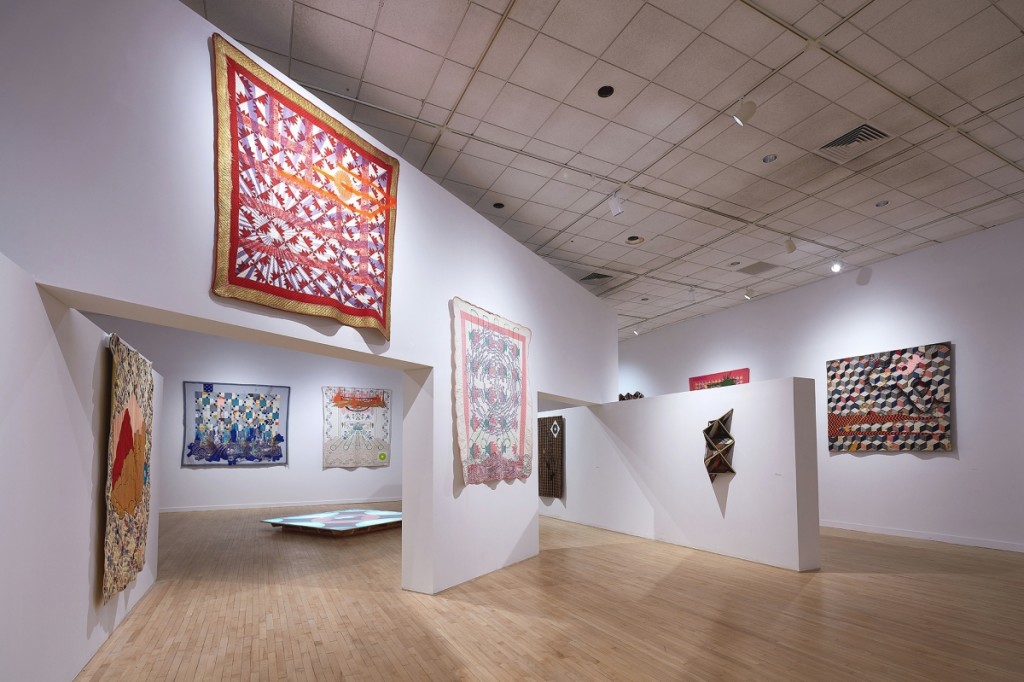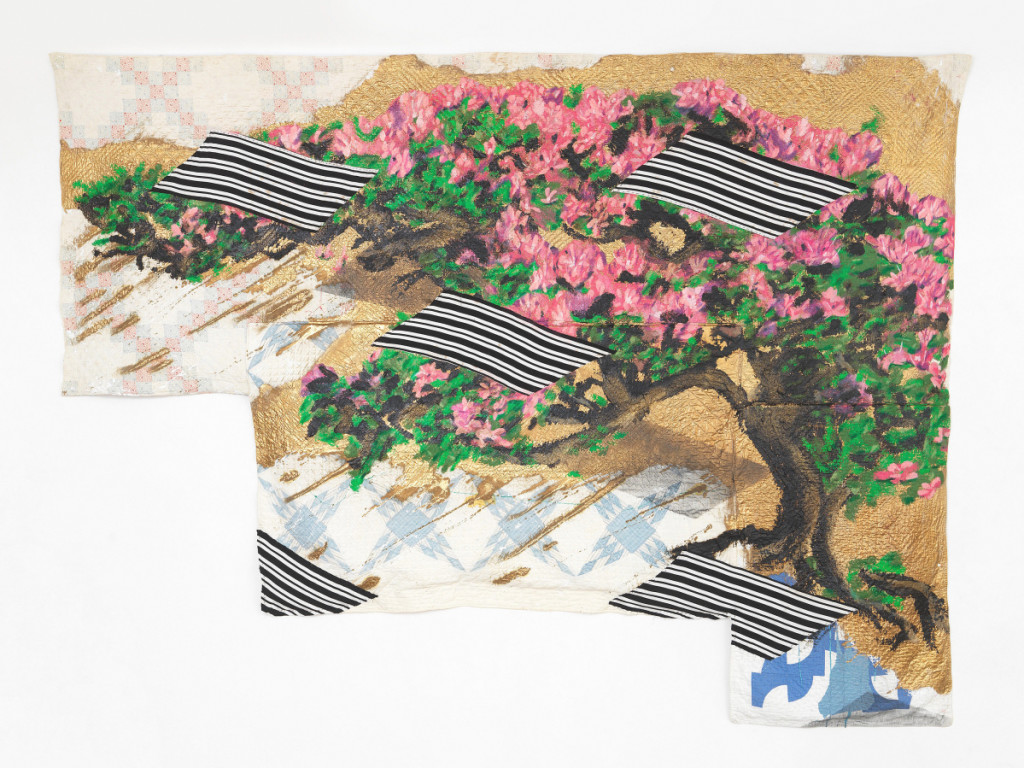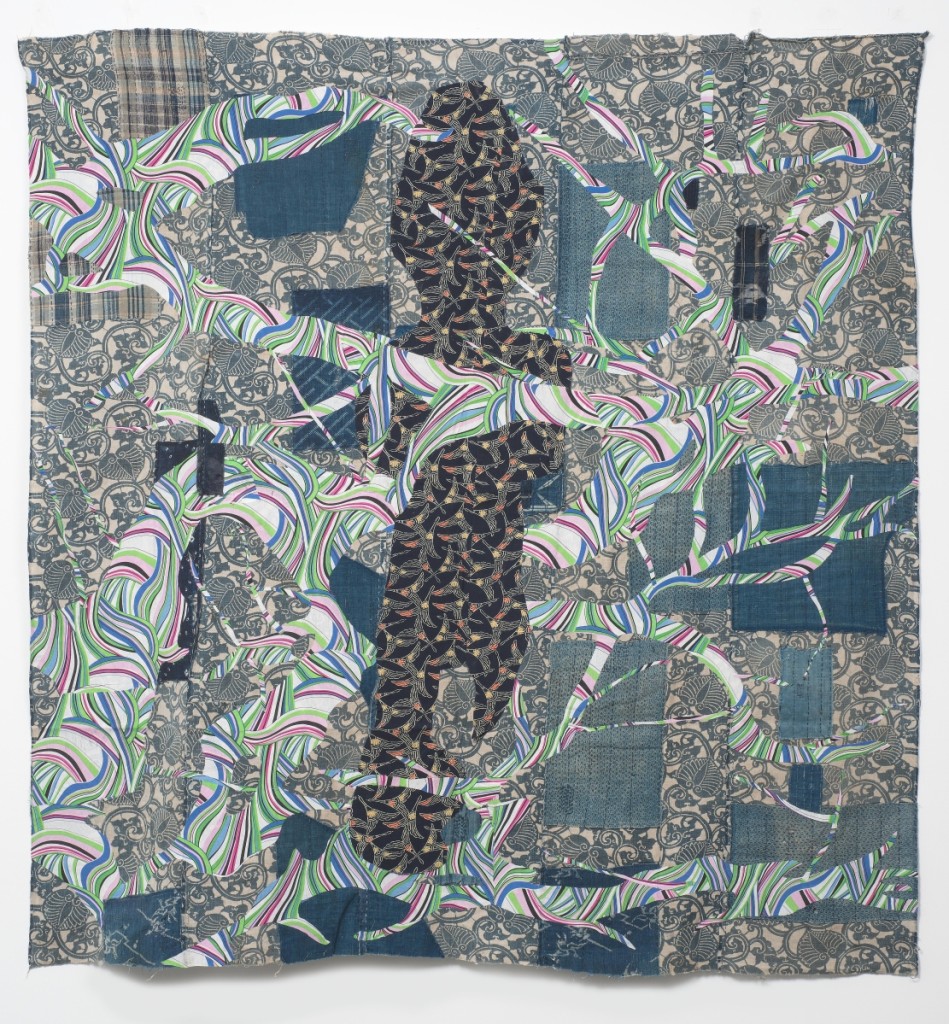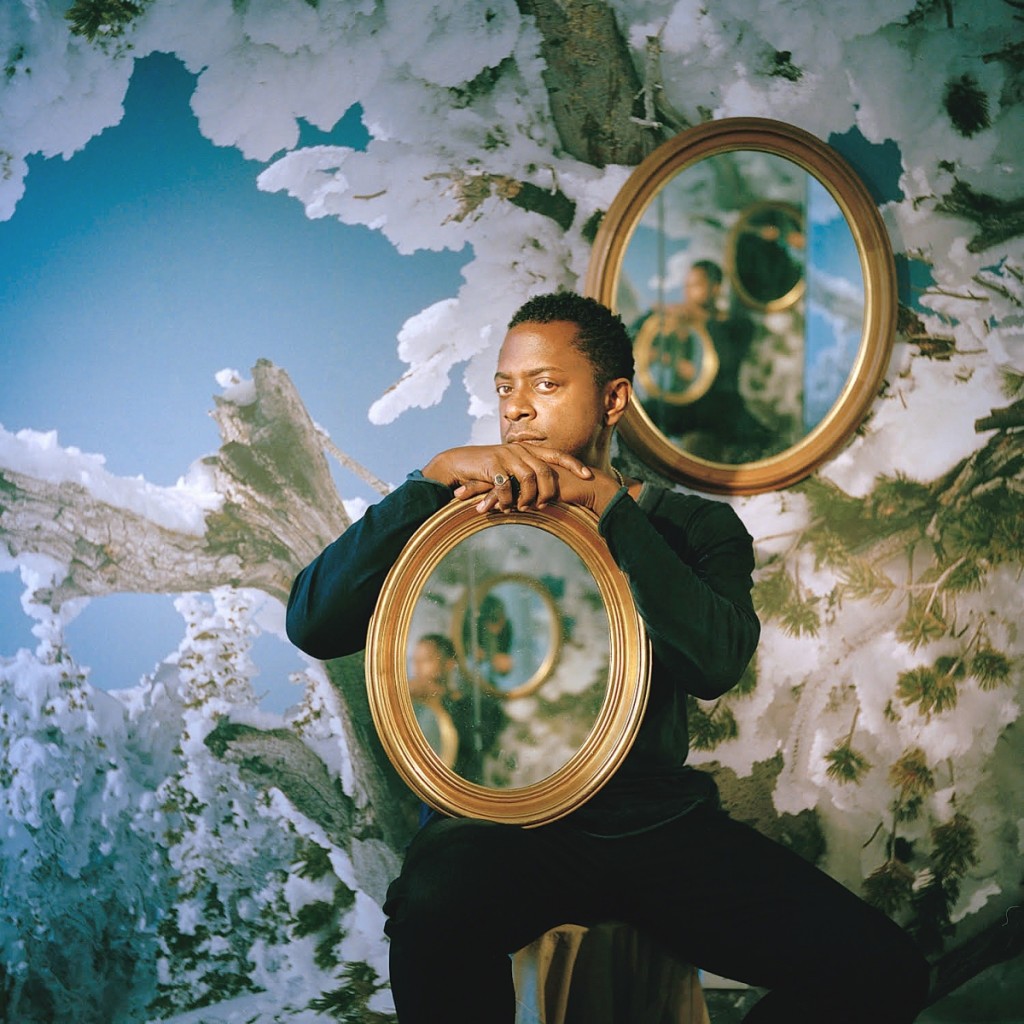By Jessica Skwire Routhier
BRONX, N.Y.- Sanford Biggers makes quilts. Or he remakes quilts. Or he destroys or deconstructs them, based on your perspective. In any case, the reclamation of this distinctively American craft tradition – and the reclamation of the actual historical quilts themselves – has been part of this interdisciplinary artist’s practice for ten years. These works are the focus of his solo exhibition, “Sanford Biggers: CodeSwitch,” on view at the Bronx Museum of the Arts through January 24, 2021. The exhibition will travel to the Museum of African Art in Los Angeles and the Contemporary Art Center in New Orleans.
Biggers has been active in the contemporary art scene for a while, though enough under the radar that a New Yorker profile in 2018 was able to lead with a description of him as “under-sung.” In that article, curator Eugenie Tsai speculated that this is at least partly because Biggers has traditionally bounced around different media, from painting to sculpture to music (he performs in a “multimedia concept band” called Moon Medicin.) One early work, for instance, made in collaboration with Jennifer Zackin, is a video installation featuring a split-screen showing near-identical Super 8 home movies from the artists’ middle-class childhoods, one white (Zackin) and one black (Biggers). In reference to that body of work, Biggers told the New Yorker: “What I want to do is code-switch.”
The term is used in contemporary parlance to refer to the necessity of adjusting or even dissembling one’s mode of communication depending on the audience. It has been used, in particular, and sometimes critically, to describe the way that black public figures – Barack Obama, Oprah Winfrey – slip between what is perceived as polished, formal speech and something approaching African American Vernacular English. By adopting the phrase as the title for his show – and by giving his series of quilt works the collective title “Codex” – Biggers signals his willingness, even eagerness, to invite conversation and debate about what his works seem to say, what they mean to say, and what they are really saying. Discussing the “Codex” works recently with Interview magazine, Biggers said: “I don’t think these are going to be really, totally understood until someone unearths them decades down the line.”

Installation view, “Sanford Biggers: CodeSwitch” at the Bronx Museum of the Arts through January 24, 2021. Photo Argenis Apolinario.
The curators of the present exhibition – Andrea Andersson of the Rivers Institute for Contemporary Art and Thought in New Orleans and Sergio Bessa of the Bronx Museum – say that their desire to showcase these works came about, in part, from their shared interest in text and language. Although Biggers’ quilts do not incorporate actual text, spoken and visual language are nevertheless key to their creation and presentation. In the catalog that accompanies the exhibition (disclaimer: I proofread the catalog for Yale University Press), Bessa describes how a 2009 commission for Philadelphia’s Mother Bethel African Methodist Episcopal Church inspired the artist to research visual traditions connected to the Underground Railroad, in which the church played a central role. In doing so, he discovered the theory that quilts of the time carried coded messages to those escaping slavery: distinctive designs hung over a fence or displayed in a window might convey “keep moving,” “safe house” or “rest here.” The Mother Bethel commission was the first in which he used historical quilts as the matrix for his painted, torn and stitched interventions.
He has continued that work ever since, interspersed with his ongoing experimentations in digital, performance and installation art. “Moon over Ninevah Bay,” for example, begins with an antique quilt in a Diamond Star pattern, popular in the antebellum era. Atop more than half of it, Biggers has overlaid a series of beige shapes that, together, give a sense of clouds or a receding riverway. On top of that are fragments from another Diamond Star quilt, each one casting a shadow upon the landscape. “Harlem Blue” is a more painterly intervention, with swaths of acrylic and spray paint – including Hiroshige-like waves along the bottom edge – adorning a simpler block-pattern quilt. Biggers does not provide dates or places of origins for the quilts that he uses, but this one, among others in the “Codex” series, suggests the Twentieth Century quilting traditions of African American communities like Gee’s Bend, Ala.
The theory of coded messages in historical quilts, while appealing, is much contested; nevertheless, Andersson says, the artist “has been quite clear that the veracity of this explanation is not of particular consequence to him.” Biggers instead grapples with the ways in which material things communicate in ways that can change over time and with different audiences. This is part of why he argues that his works elude interpretation in this moment of their creation – not because he believes that he holds a single key to their meaning that is beyond contemporary understanding, but because he appreciates that their meaning is not fixed. They are “multidirectional,” says Andersson, “if there is ever a word that lives so snugly in Sanford’s practices…. These maps don’t go to one place…and time does not go in one direction, and that’s part of what’s at stake in this work.”

“Bonsai” by Sanford Biggers, 2016. Antique quilt, assorted textiles, spray paint, oil stick, tar, 69 by 93 inches. ©Sanford Biggers and Marianne Boesky Gallery. Photo Object Studies.
Although the Underground Railroad, and the purported role of quilts within it, is the clear point of departure for Biggers’ “Codex” series, the works in the exhibition cover far more territory, historically and culturally speaking. The visual vocabulary of antebellum quilts coexists with references to Twentieth Century and contemporary culture, from jazz and the Civil Rights Movement to hip-hop and the current crisis of police violence against unarmed black men. Language again comes into play in the titles of these works. “Chorus for Paul Mooney” is named for the comedian whose controversial standup act often disparaged code-switching within the black community. Its slashing zigzags of striped blue and black fabric across a haphazardly patchworked background suggests the unapologetic disorderliness of the comedian’s messaging. “The Talk,” while perhaps open to interpretation, may allude to the coming-of-age talk that black parents have with their sons: not about the birds and the bees, but how to avoid being killed by the police. The background for this work is an antique quilt rendered in circles of black and white; over it, Biggers has stitched three standing figures in black and white stripes who cast a long diagonal shadow, as if cast by headlights.
The fact that Biggers is a man participating in what is traditionally seen as women’s work is not lost on the artist. “I think that intervention, that disruption of gender histories, is also very important to him,” says Andersson. “There’s an intersection of politics to the work, which is to say that it becomes a meeting ground for different histories…. What does it mean when these seams begin to touch?” In Interview, Biggers acknowledged being an “interloper” among “hardcore quilters” but noted that, nevertheless, “weird relationships happen because of the material, because of the nostalgia and Americana and community aspect.” Accordingly, the craft aspect of quilts is central to Biggers’ work. Bessa and Andersson note that Biggers does not use studio assistants for the quilts and “only Sanford touches them,” making them very much a handmade endeavor – and thus a departure, to some extent, from work on related themes by male artists like Robert Rauschenberg and Sam Gilliam.
The primacy of the handmade is evident not only in Biggers’ wall-hung pieces, which retain the general structure and footprint of the original quilts from which they are made, but also in his sculptural quilted pieces. In works like “Incidental Geometry” and the aptly titled “Reconstruction,” Biggers doubles down on the modular, additive quality of quilts, literally disassembling them into uniform square or triangular fragments and then reassembling them in three dimensions. These works reflect the artist’s interest in sacred geometries and the influence of Eastern philosophies, but they are still very much the work of an American artist. The predominant red, white and blue fabrics – actual American flags, in the case of “Reconstruction” – encased in a series gold-leafed triangulated strip frames suggest the folded flags given to the families of fallen soldiers, seemingly alluding to a class of objects that are perennially revered, preserved and considered above reproach.

“Beloved” by Sanford Biggers, 2017. Antique futon cover, assorted textiles. 40 by 38 inches. ©Sanford Biggers and Marianne Boesky Gallery.
Biggers clearly means to problematize such a reverence for objects; his very act of altering historic quilts (and, in other contexts, antique African sculptures) conveys an ambivalent attitude toward preservation. Still, Bessa perceives that Biggers has “tenderly handled” the historical objects with which he works. He points to the artist’s adoption of kintsugi, the Japanese technique for filling cracks in pottery with gold or silver, thus making the flaw part of the beauty of the piece. This can be seen in wall-hung pieces like “The Tyranny of Mirrors,” which uses actual silver leaf, but also in works like “Beloved,” in which a vivid, Pucci-esque fabric fills the shattered gaps in an antique futon cover. In such works, says Bessa, Biggers is “taking this American history which is so painful and…bringing it into a totally different context…of a different culture that cares for broken things. It’s like taking our broken history and mending it in this very poetic way.”
As much as this kind of patchwork surface has come to be associated with quilts, it is in fact layers that are their defining quality: two layers of fabric with filling in between, stitched or “quilted” together. One way to look at Biggers’ quilts, Andersson says, is as a kind of layering of our contemporary moment on top of a historical moment. But “there’s another way of interpreting these works,” she says, “which is that this is history in process… Part of the history of quilting, full stop, is the sense of continuity, of community, of change.” This perspective makes decoding the works seem almost beside the point. As Bessa notes, the quilts that Biggers uses “already come steeped in history,” and so no matter what other codes or histories he layers over, under, or within that – contested, personal, future – the material fact of the quilt remains the support and structure behind it.
“I think there is much more to be said about the potential for how they might be read,” says Andersson of both Civil War-era quilts and Biggers’ interventions upon them, “and also to think about the ways that we tell stories and tell histories, and what is truth for some and can be easily dismantled or disregarded by others.”
The Bronx Museum of the Arts is at 1040 Grand Concourse. For more information, www.bronxmuseum.org or 718-681-6000.

















